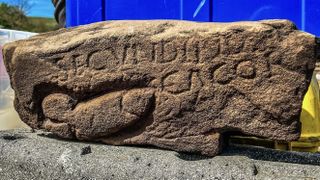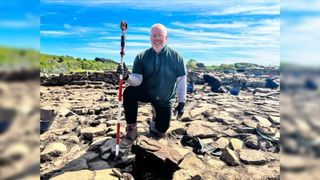Penis graffiti and explicit insult carved into ancient stone 'raises eyebrows' at Roman fort
The stone's carver made their feeling toward a fellow soldier crystal clear.

Archaeologists in the U.K. recently had their "eyebrows raised" when they discovered an X-rated carving on a stone at a Roman fort. The graffiti features a crude penis accompanied by a phrase that experts say translates to "the shitter" next to someone's name, and it seems to have been etched out by a Roman soldier to insult a comrade.
The stone, which is 16 inches (40 centimeters) wide and 6 inches (15 cm) tall, was uncovered May 19 at Vindolanda, the ruins of a Roman fort just south of Hadrian's Wall — a fortified structure that served as the northern frontier of the Roman Empire, built across England to defend Roman Britain against the unconquered Picts in Caledonia (made up of modern-day Scotland and some of northern England). The archaeologists think the graffiti was carved into the stone sometime during the third century A.D.
Volunteer archaeologist Dylan Herbert, a retired biochemist from Wales, unearthed the stone during his second week at the excavation site. Herbert had wanted to remove the stone, which he kept tripping over while excavating, for several days before he was given the green light to remove it. (The Vindolanda Charitable Trust responsible for excavating the site relies on unpaid volunteers to assist archaeologists in properly exploring the expansive site.)
"It looked from the back like all the others, a very ordinary stone, but when I turned it over, I was startled to see some clear letters," Herbert said in a statement. "Only after we removed the mud did I realize the full extent of what I'd uncovered, and I was absolutely delighted."
Related: Prehistoric rock carvings may have been the first cartoons in history, new study suggests
The stand-out feature of the stone is the girthy graffiti, but researchers were more interested in the writing that accompanied it. Experts recognized the phrase "SECUNDINUS CACOR" as an abbreviation of "Secundinus cacator," which translates to "Secundinus, the shitter," according to the statement.
"The recovery of an inscription, a direct message from the past, is always a great event on a Roman excavation [site]," Andrew Birley, director of excavations and CEO of the Vindolanda Charitable Trust, said in the statement. "But this one really raised our eyebrows when we deciphered the message on the stone."
Sign up for the Live Science daily newsletter now
Get the world’s most fascinating discoveries delivered straight to your inbox.

Phallus carvings were not uncommon in the Roman Empire: The new carving is the 13th phallus uncovered at Vindolanda, and only a quarter of the site has been fully excavated. In June 2021, a carving of a naked horseman and his exposed member was also uncovered at Vindolanda. Phalluses were normally carved as a symbol of good luck or fertility, according to the statement.
However, the recently discovered graffiti is clearly meant as an insult, which surprised researchers. The depth of the lines carved into the rock suggests that the artist spent a lot of time working away at the stone, which highlights how passionately they despised Secundinus, according to the statement.
Placing the stone somewhere visible at the fort would have been one of the most effective ways to shame someone at the time. The new carving is the Roman equivalent of badmouthing someone on social media today, the researchers wrote in the statement. "Its author clearly had a big problem with Secundinus and was confident enough to announce their thoughts publicly," Birley said. "I have no doubt that Secundinus would have been less than amused to see this when he was wandering around the site over 1,700 years ago."
Originally published on Live Science.

Harry is a U.K.-based senior staff writer at Live Science. He studied marine biology at the University of Exeter before training to become a journalist. He covers a wide range of topics including space exploration, planetary science, space weather, climate change, animal behavior, evolution and paleontology. His feature on the upcoming solar maximum was shortlisted in the "top scoop" category at the National Council for the Training of Journalists (NCTJ) Awards for Excellence in 2023.
Most Popular


